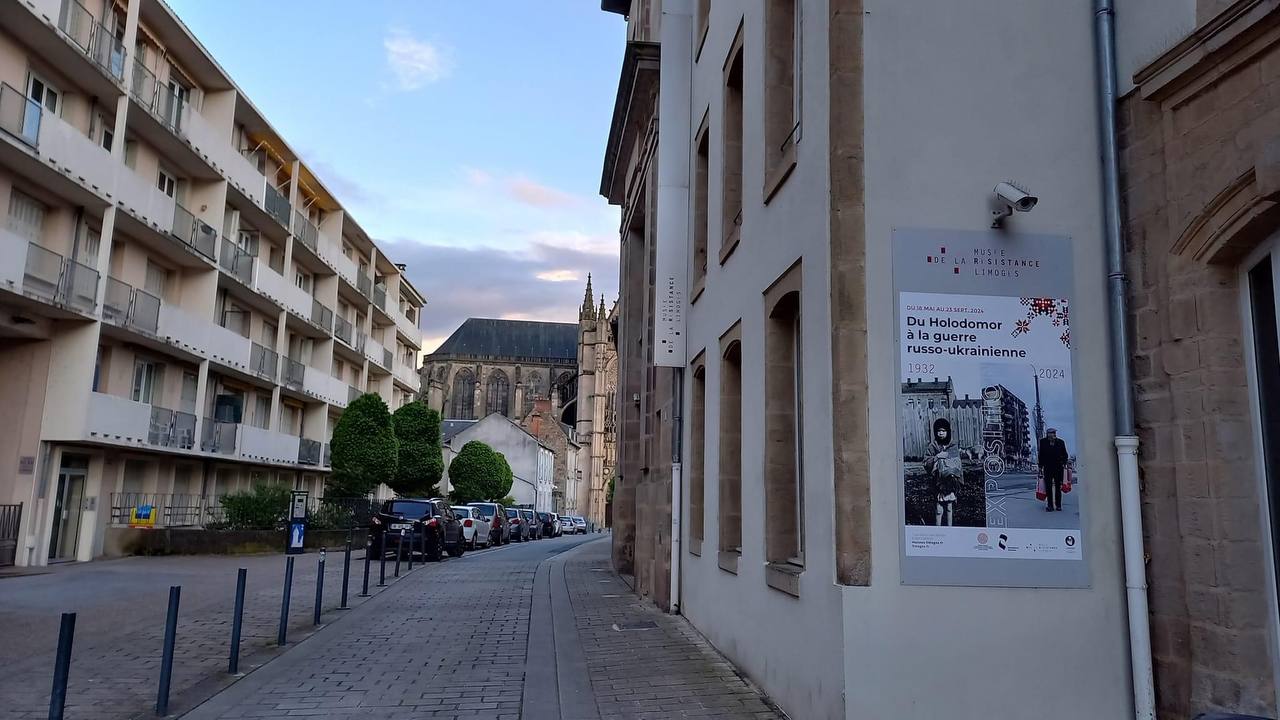An exhibition opened in France, with the exhibits supplied by the Holodomor Museum
On May 18, 2024, the exhibition “From the Holodomor to the Russian-Ukrainian War” opened at the Museum of Resistance in the French city of Limoges. For this project, the Holodomor Museum provided exhibits from its stock collection, and this is the first time in the years of the institution’s work that museum artefacts went to be on display abroad.
“At the beginning of the Russian full-scale invasion, we were approached by colleagues from the Platform of European Memory and Conscience, which includes the Holodomor Museum and the Museum of Resistance in Limoges, to show an exhibition about the Holodomor in France. Of course, we agreed. Because for us, it is an opportunity to tell the French audience about the Holodomor history and draw attention to the modern crimes of the Russian Federation against Ukraine. In addition, the Museum of Resistance in Limoges is dedicated to the history of the French resistance during the Second World War and tells in particular about the role of the French communists in it. We remember the history of the denial of the Holodomor by some French political and cultural figures who sympathised with the USSR for a long time.The initiative of the Museum of Resistance to show such an exhibition shows their policy of openness and a critical approach to the events of the past,” says Yana Hrynko, head of the exposition and exhibition department of the Holodomor Museum.
Artefacts from the collection of the National Museum of the Holodomor Genocide form the basis of this exhibition. The authentic things from the beginning of the 20th century tell the stories of Ukrainians who lived during the Holodomor. There is a wooden spoon of Parfil Kravchuk from Zhytomyr region, who saved his granddaughter and her son. Granddaughter Anastasia kept her grandfather’s spoon for decades and passed it on to her descendants, telling the family story. Oleksii Vobly’s tablecloth and photo with his students from the early 1930s tell the story of an exceptional teacher’s humanity and courage. He saved all the children of the village of Piskoshyne in the Zaporizhzhia region from starvation. A manual mill, created during the Holodomor by an unknown Ukrainian farmer for grinding grain or, in most cases, surrogates because ordinary millstones were seized or broken by the communists so that people could not prepare food. Among the presented exhibits are also the letters of the South African engineer Jerry Berman, which he wrote to his family from Stanytsia Luhanska in 1933 after witnessing the extermination of Ukrainians. The book of the French politician Edouard Herriot, in which he writes about his visit to Ukraine in 1933 and denies the Holodomor, has a prominent place in the exposition. It is a demonstrative example of the consequences of lies, propaganda and distortion of the truth about the tragic events in Soviet Ukraine.
The total number of exhibits transferred to the exhibition is 30 items. Each of the artefacts testifies to different facts and aspects of the history of the Holodomor.
The exhibits complement the posters of the “Holodomor: Soviet Genocide” exhibition, which were prepared by the Holodomor Museum team and translated into French by the Annecy Ukraine Association. This part explains the causes, course, and consequences of the Holodomor, as well as modern narratives of denial of the crime. It will allow visitors to learn the historical context.
“We see how the visitors react to the exhibition: their faces are touched, full of emotions. During the Night at the Museum, some visitors said: “This is scary,” shares the director of the Museum of Resistance, Annie Martin, after the first week of the exhibition.
The exposition continues in the next hall of the Museum of Resistance with a story about interstate relations between Ukraine and Russia from 1991, when the Soviet Union collapsed, till 2024 when a full-scale Russian invasion is in full swing. This content is illustrated by photos from the collection of the National Memorial Complex of the Heroes of the Heavenly Hundred “Museum of the Revolution of Dignity” (three Ukrainian revolutions) and photos of the Russian war against Ukraine, taken by the French photographer of Ukrainian origin Yurii Bilak. The photographs are accompanied by curatorial texts by the staff of the Museum of Resistance and the Holodomor Museum, as well as Professor Antoine Arjakovsky.
“This project is very important in France. First of all, it is sad to say this, but for the first time such an exhibition about the Holodomor is being presented in France. For too long, our authorities preferred not to comment on the issue of the genocide of Ukrainians in 1932-1933. Only in June 2023 was Holodomor recognised as an act of genocide at the state level. In addition, this exhibition shows the connection between the Holodomor and the Russian-Ukrainian war since 2014. Denial of the 1932-1933 genocide led to its justification and repetition. I hope that this exhibition will be the beginning of a long-term cooperation”, – emphasised the co-curator of the exhibition, the director of scientific research of the Bernardine College, Antoine Arjakovsky.
The exhibition in Limoges will last until September 23 this year.
